Managing Digital Transformation: A Project Management Plan for Next
VerifiedAdded on 2023/06/07
|32
|6645
|256
Report
AI Summary
This report presents a comprehensive project management plan focused on digital workplace transformation, specifically examining its application within Next Plc. The plan outlines the stages of the project lifecycle, key factors for consideration, and relevant research methods. It includes a detailed work breakdown structure and schedule, along with findings from both primary and secondary research. The primary research involves data collection through questionnaires, while secondary research explores digital transformation initiatives in other organizations and the value of innovative digital tools. The report concludes with meaningful recommendations derived from the data analysis and a reflection on the value of the project in meeting stated objectives and personal learning.

MANAGING A
SUCCESSFUL
BUSINESS PROJECT
SUCCESSFUL
BUSINESS PROJECT
Paraphrase This Document
Need a fresh take? Get an instant paraphrase of this document with our AI Paraphraser
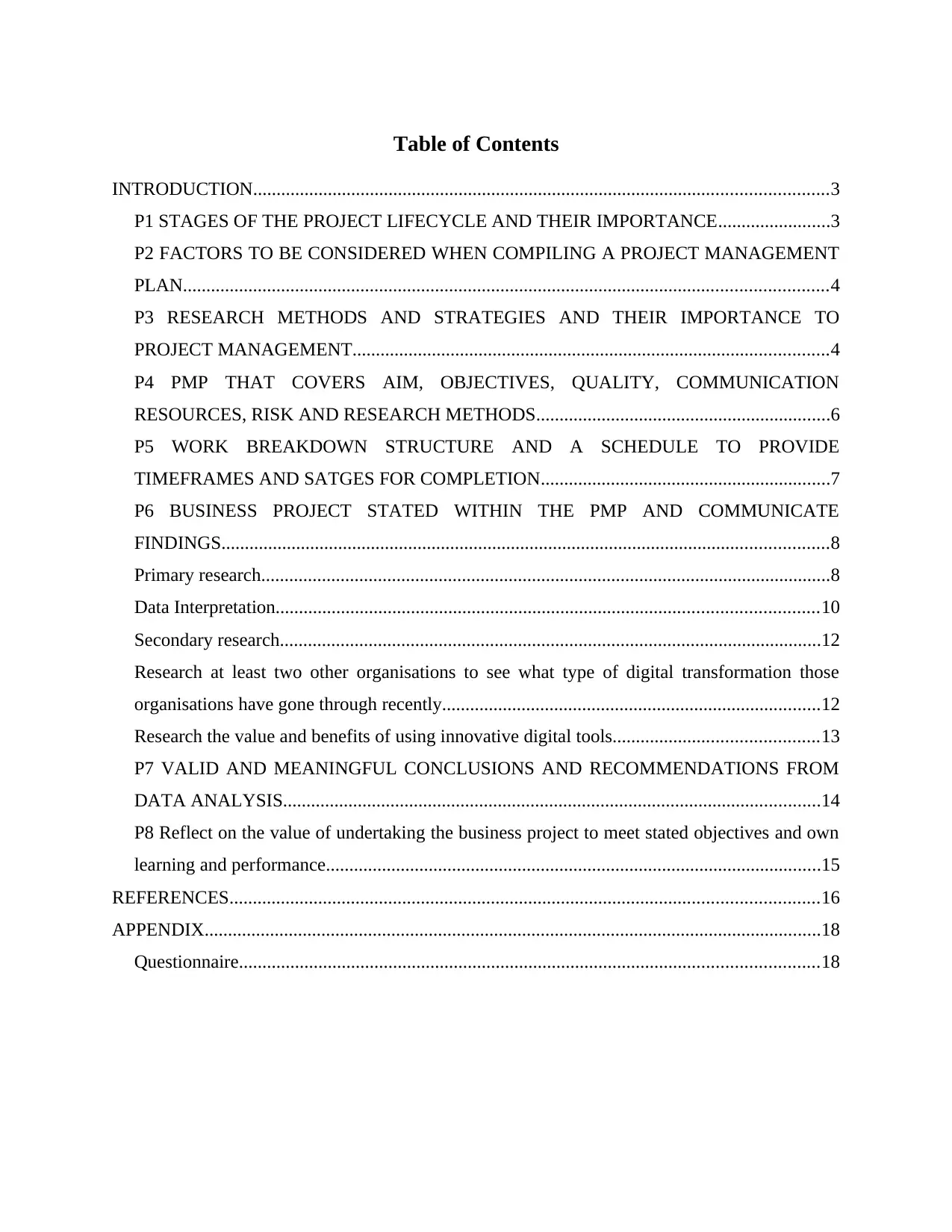
Table of Contents
INTRODUCTION...........................................................................................................................3
P1 STAGES OF THE PROJECT LIFECYCLE AND THEIR IMPORTANCE........................3
P2 FACTORS TO BE CONSIDERED WHEN COMPILING A PROJECT MANAGEMENT
PLAN..........................................................................................................................................4
P3 RESEARCH METHODS AND STRATEGIES AND THEIR IMPORTANCE TO
PROJECT MANAGEMENT......................................................................................................4
P4 PMP THAT COVERS AIM, OBJECTIVES, QUALITY, COMMUNICATION
RESOURCES, RISK AND RESEARCH METHODS...............................................................6
P5 WORK BREAKDOWN STRUCTURE AND A SCHEDULE TO PROVIDE
TIMEFRAMES AND SATGES FOR COMPLETION..............................................................7
P6 BUSINESS PROJECT STATED WITHIN THE PMP AND COMMUNICATE
FINDINGS..................................................................................................................................8
Primary research..........................................................................................................................8
Data Interpretation....................................................................................................................10
Secondary research....................................................................................................................12
Research at least two other organisations to see what type of digital transformation those
organisations have gone through recently.................................................................................12
Research the value and benefits of using innovative digital tools............................................13
P7 VALID AND MEANINGFUL CONCLUSIONS AND RECOMMENDATIONS FROM
DATA ANALYSIS...................................................................................................................14
P8 Reflect on the value of undertaking the business project to meet stated objectives and own
learning and performance..........................................................................................................15
REFERENCES..............................................................................................................................16
APPENDIX....................................................................................................................................18
Questionnaire............................................................................................................................18
INTRODUCTION...........................................................................................................................3
P1 STAGES OF THE PROJECT LIFECYCLE AND THEIR IMPORTANCE........................3
P2 FACTORS TO BE CONSIDERED WHEN COMPILING A PROJECT MANAGEMENT
PLAN..........................................................................................................................................4
P3 RESEARCH METHODS AND STRATEGIES AND THEIR IMPORTANCE TO
PROJECT MANAGEMENT......................................................................................................4
P4 PMP THAT COVERS AIM, OBJECTIVES, QUALITY, COMMUNICATION
RESOURCES, RISK AND RESEARCH METHODS...............................................................6
P5 WORK BREAKDOWN STRUCTURE AND A SCHEDULE TO PROVIDE
TIMEFRAMES AND SATGES FOR COMPLETION..............................................................7
P6 BUSINESS PROJECT STATED WITHIN THE PMP AND COMMUNICATE
FINDINGS..................................................................................................................................8
Primary research..........................................................................................................................8
Data Interpretation....................................................................................................................10
Secondary research....................................................................................................................12
Research at least two other organisations to see what type of digital transformation those
organisations have gone through recently.................................................................................12
Research the value and benefits of using innovative digital tools............................................13
P7 VALID AND MEANINGFUL CONCLUSIONS AND RECOMMENDATIONS FROM
DATA ANALYSIS...................................................................................................................14
P8 Reflect on the value of undertaking the business project to meet stated objectives and own
learning and performance..........................................................................................................15
REFERENCES..............................................................................................................................16
APPENDIX....................................................................................................................................18
Questionnaire............................................................................................................................18
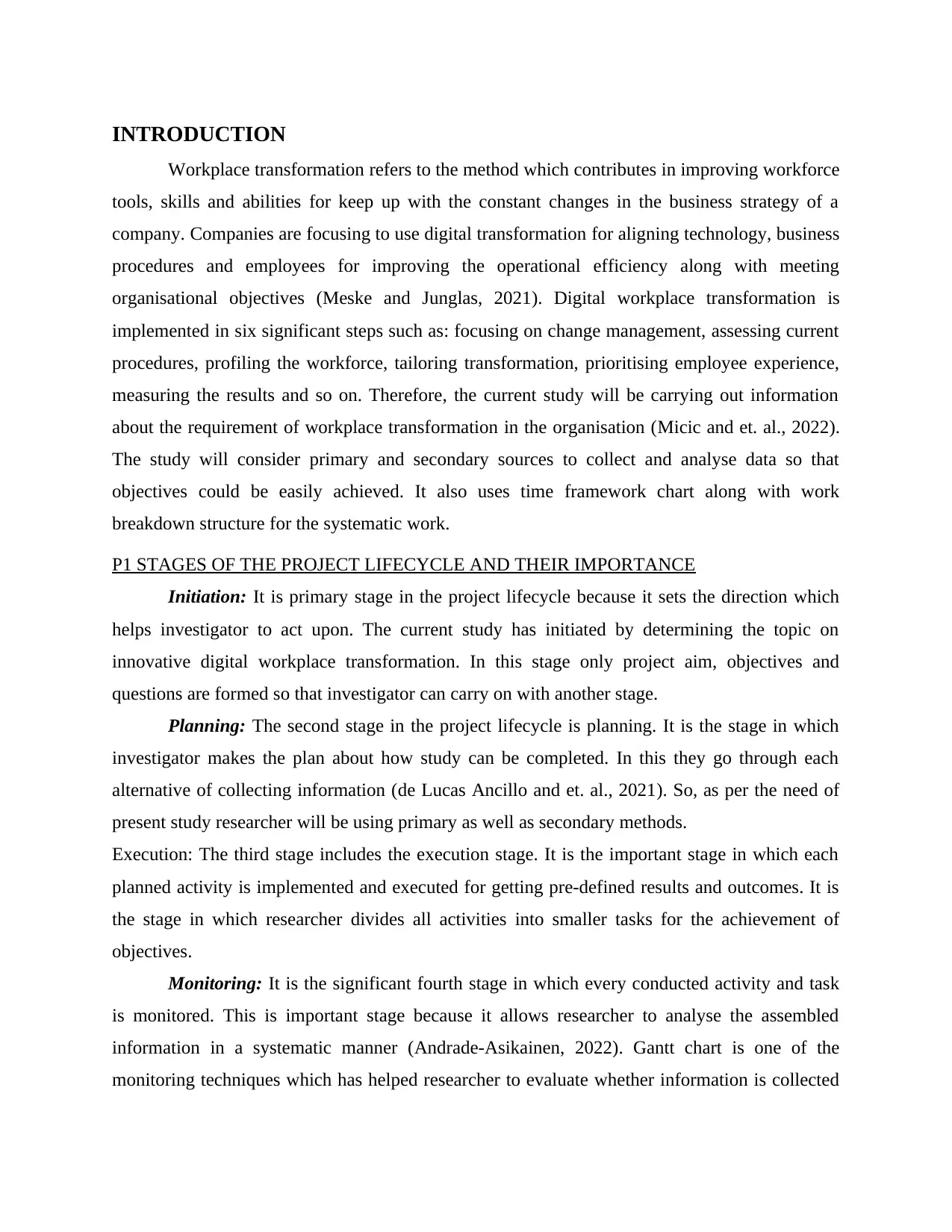
INTRODUCTION
Workplace transformation refers to the method which contributes in improving workforce
tools, skills and abilities for keep up with the constant changes in the business strategy of a
company. Companies are focusing to use digital transformation for aligning technology, business
procedures and employees for improving the operational efficiency along with meeting
organisational objectives (Meske and Junglas, 2021). Digital workplace transformation is
implemented in six significant steps such as: focusing on change management, assessing current
procedures, profiling the workforce, tailoring transformation, prioritising employee experience,
measuring the results and so on. Therefore, the current study will be carrying out information
about the requirement of workplace transformation in the organisation (Micic and et. al., 2022).
The study will consider primary and secondary sources to collect and analyse data so that
objectives could be easily achieved. It also uses time framework chart along with work
breakdown structure for the systematic work.
P1 STAGES OF THE PROJECT LIFECYCLE AND THEIR IMPORTANCE
Initiation: It is primary stage in the project lifecycle because it sets the direction which
helps investigator to act upon. The current study has initiated by determining the topic on
innovative digital workplace transformation. In this stage only project aim, objectives and
questions are formed so that investigator can carry on with another stage.
Planning: The second stage in the project lifecycle is planning. It is the stage in which
investigator makes the plan about how study can be completed. In this they go through each
alternative of collecting information (de Lucas Ancillo and et. al., 2021). So, as per the need of
present study researcher will be using primary as well as secondary methods.
Execution: The third stage includes the execution stage. It is the important stage in which each
planned activity is implemented and executed for getting pre-defined results and outcomes. It is
the stage in which researcher divides all activities into smaller tasks for the achievement of
objectives.
Monitoring: It is the significant fourth stage in which every conducted activity and task
is monitored. This is important stage because it allows researcher to analyse the assembled
information in a systematic manner (Andrade-Asikainen, 2022). Gantt chart is one of the
monitoring techniques which has helped researcher to evaluate whether information is collected
Workplace transformation refers to the method which contributes in improving workforce
tools, skills and abilities for keep up with the constant changes in the business strategy of a
company. Companies are focusing to use digital transformation for aligning technology, business
procedures and employees for improving the operational efficiency along with meeting
organisational objectives (Meske and Junglas, 2021). Digital workplace transformation is
implemented in six significant steps such as: focusing on change management, assessing current
procedures, profiling the workforce, tailoring transformation, prioritising employee experience,
measuring the results and so on. Therefore, the current study will be carrying out information
about the requirement of workplace transformation in the organisation (Micic and et. al., 2022).
The study will consider primary and secondary sources to collect and analyse data so that
objectives could be easily achieved. It also uses time framework chart along with work
breakdown structure for the systematic work.
P1 STAGES OF THE PROJECT LIFECYCLE AND THEIR IMPORTANCE
Initiation: It is primary stage in the project lifecycle because it sets the direction which
helps investigator to act upon. The current study has initiated by determining the topic on
innovative digital workplace transformation. In this stage only project aim, objectives and
questions are formed so that investigator can carry on with another stage.
Planning: The second stage in the project lifecycle is planning. It is the stage in which
investigator makes the plan about how study can be completed. In this they go through each
alternative of collecting information (de Lucas Ancillo and et. al., 2021). So, as per the need of
present study researcher will be using primary as well as secondary methods.
Execution: The third stage includes the execution stage. It is the important stage in which each
planned activity is implemented and executed for getting pre-defined results and outcomes. It is
the stage in which researcher divides all activities into smaller tasks for the achievement of
objectives.
Monitoring: It is the significant fourth stage in which every conducted activity and task
is monitored. This is important stage because it allows researcher to analyse the assembled
information in a systematic manner (Andrade-Asikainen, 2022). Gantt chart is one of the
monitoring techniques which has helped researcher to evaluate whether information is collected
⊘ This is a preview!⊘
Do you want full access?
Subscribe today to unlock all pages.

Trusted by 1+ million students worldwide
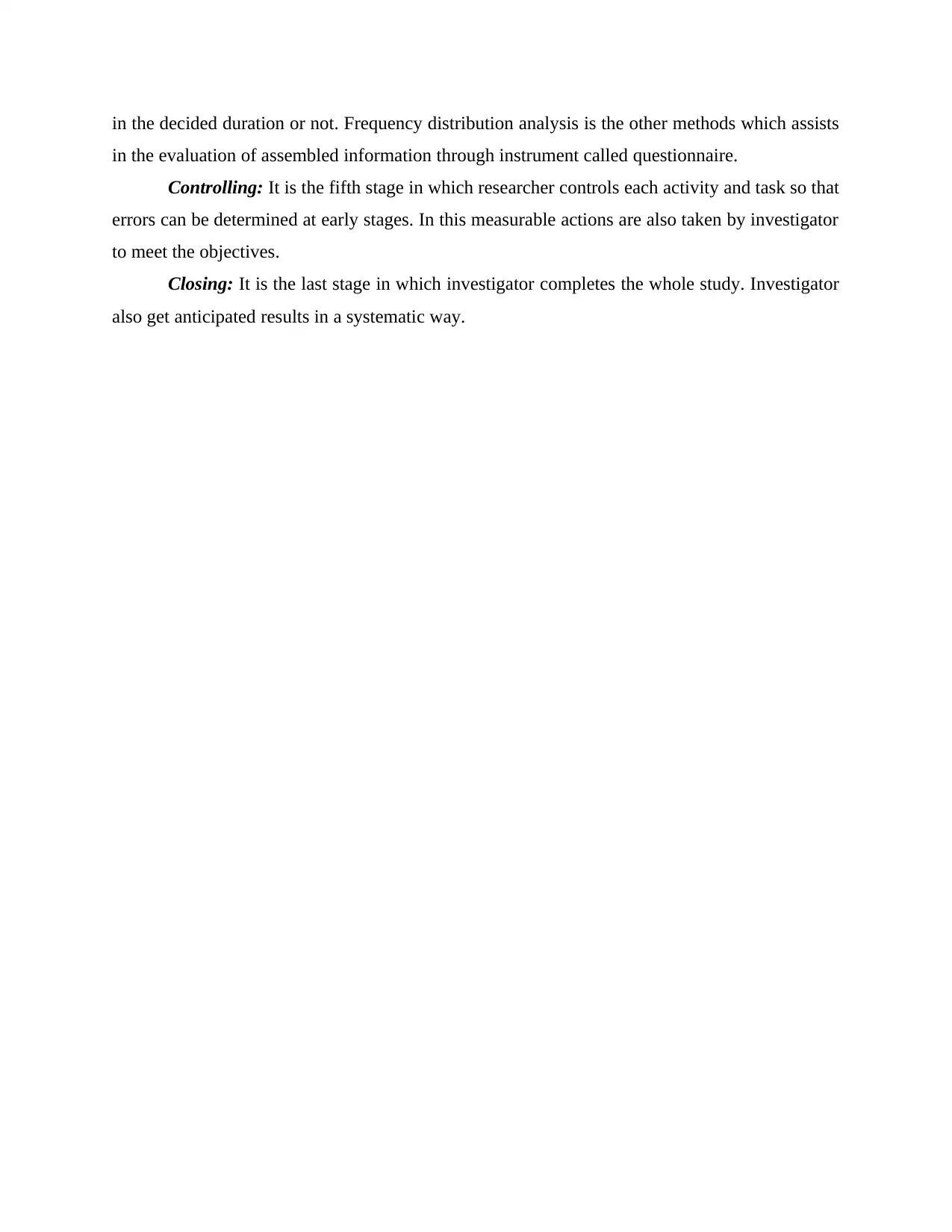
in the decided duration or not. Frequency distribution analysis is the other methods which assists
in the evaluation of assembled information through instrument called questionnaire.
Controlling: It is the fifth stage in which researcher controls each activity and task so that
errors can be determined at early stages. In this measurable actions are also taken by investigator
to meet the objectives.
Closing: It is the last stage in which investigator completes the whole study. Investigator
also get anticipated results in a systematic way.
in the evaluation of assembled information through instrument called questionnaire.
Controlling: It is the fifth stage in which researcher controls each activity and task so that
errors can be determined at early stages. In this measurable actions are also taken by investigator
to meet the objectives.
Closing: It is the last stage in which investigator completes the whole study. Investigator
also get anticipated results in a systematic way.
Paraphrase This Document
Need a fresh take? Get an instant paraphrase of this document with our AI Paraphraser
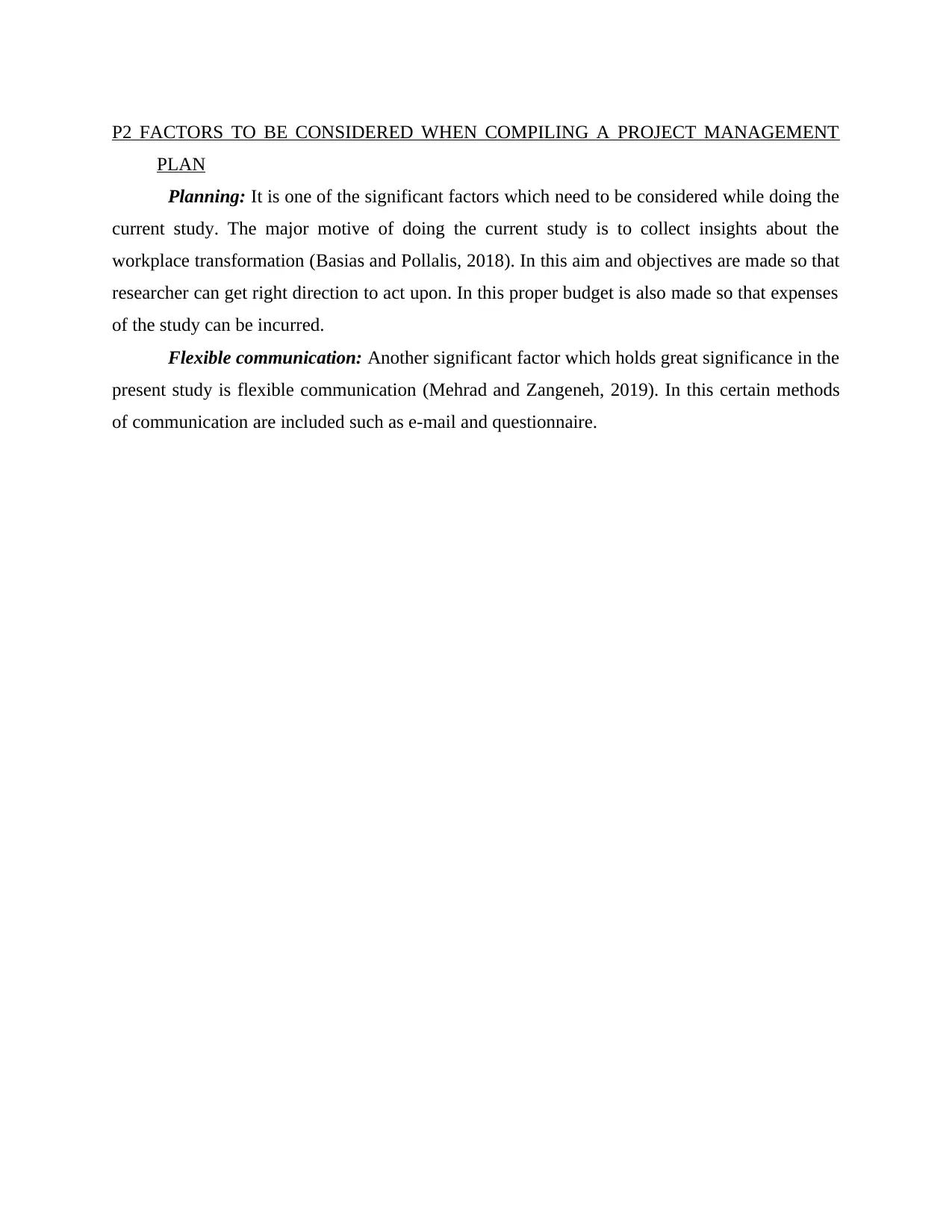
P2 FACTORS TO BE CONSIDERED WHEN COMPILING A PROJECT MANAGEMENT
PLAN
Planning: It is one of the significant factors which need to be considered while doing the
current study. The major motive of doing the current study is to collect insights about the
workplace transformation (Basias and Pollalis, 2018). In this aim and objectives are made so that
researcher can get right direction to act upon. In this proper budget is also made so that expenses
of the study can be incurred.
Flexible communication: Another significant factor which holds great significance in the
present study is flexible communication (Mehrad and Zangeneh, 2019). In this certain methods
of communication are included such as e-mail and questionnaire.
PLAN
Planning: It is one of the significant factors which need to be considered while doing the
current study. The major motive of doing the current study is to collect insights about the
workplace transformation (Basias and Pollalis, 2018). In this aim and objectives are made so that
researcher can get right direction to act upon. In this proper budget is also made so that expenses
of the study can be incurred.
Flexible communication: Another significant factor which holds great significance in the
present study is flexible communication (Mehrad and Zangeneh, 2019). In this certain methods
of communication are included such as e-mail and questionnaire.
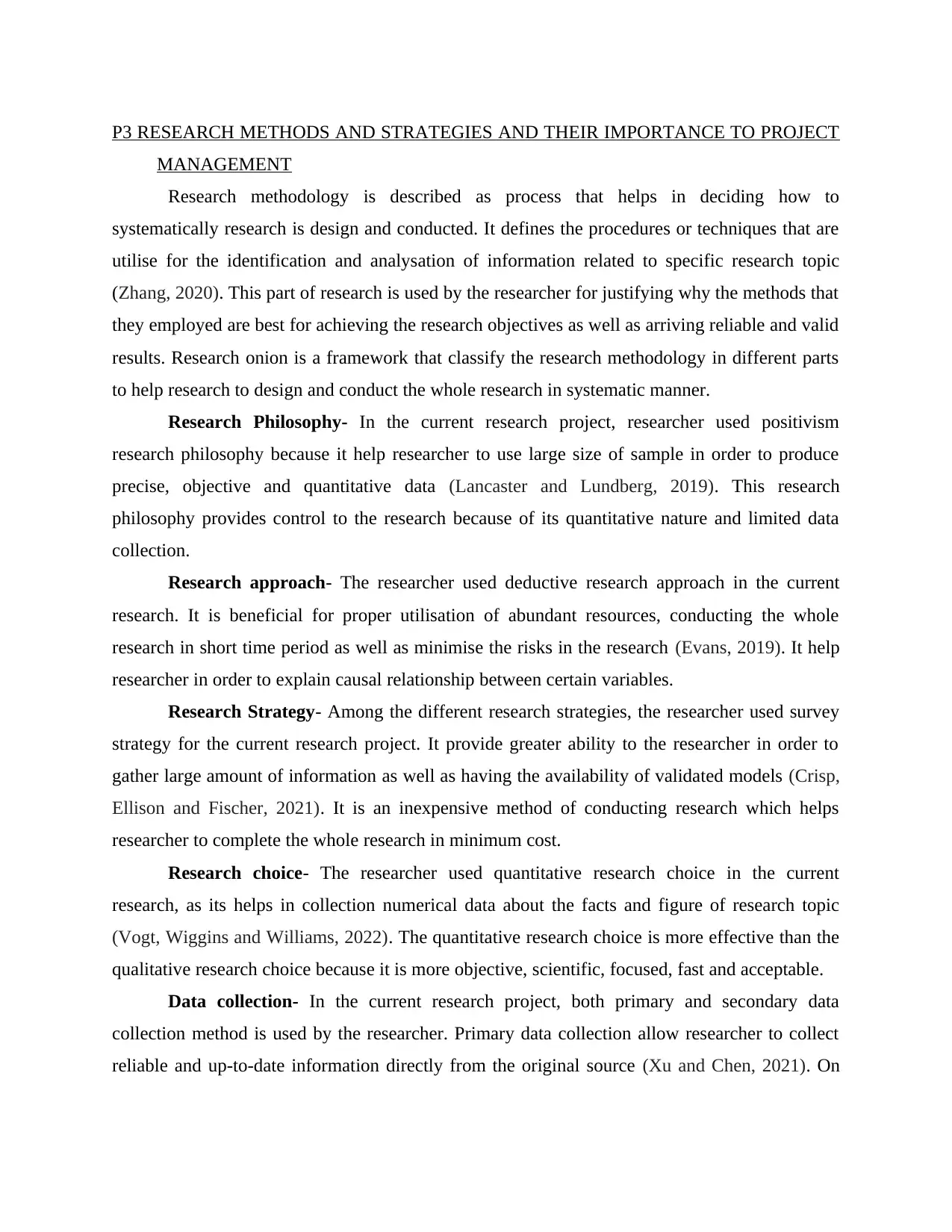
P3 RESEARCH METHODS AND STRATEGIES AND THEIR IMPORTANCE TO PROJECT
MANAGEMENT
Research methodology is described as process that helps in deciding how to
systematically research is design and conducted. It defines the procedures or techniques that are
utilise for the identification and analysation of information related to specific research topic
(Zhang, 2020). This part of research is used by the researcher for justifying why the methods that
they employed are best for achieving the research objectives as well as arriving reliable and valid
results. Research onion is a framework that classify the research methodology in different parts
to help research to design and conduct the whole research in systematic manner.
Research Philosophy- In the current research project, researcher used positivism
research philosophy because it help researcher to use large size of sample in order to produce
precise, objective and quantitative data (Lancaster and Lundberg, 2019). This research
philosophy provides control to the research because of its quantitative nature and limited data
collection.
Research approach- The researcher used deductive research approach in the current
research. It is beneficial for proper utilisation of abundant resources, conducting the whole
research in short time period as well as minimise the risks in the research (Evans, 2019). It help
researcher in order to explain causal relationship between certain variables.
Research Strategy- Among the different research strategies, the researcher used survey
strategy for the current research project. It provide greater ability to the researcher in order to
gather large amount of information as well as having the availability of validated models (Crisp,
Ellison and Fischer, 2021). It is an inexpensive method of conducting research which helps
researcher to complete the whole research in minimum cost.
Research choice- The researcher used quantitative research choice in the current
research, as its helps in collection numerical data about the facts and figure of research topic
(Vogt, Wiggins and Williams, 2022). The quantitative research choice is more effective than the
qualitative research choice because it is more objective, scientific, focused, fast and acceptable.
Data collection- In the current research project, both primary and secondary data
collection method is used by the researcher. Primary data collection allow researcher to collect
reliable and up-to-date information directly from the original source (Xu and Chen, 2021). On
MANAGEMENT
Research methodology is described as process that helps in deciding how to
systematically research is design and conducted. It defines the procedures or techniques that are
utilise for the identification and analysation of information related to specific research topic
(Zhang, 2020). This part of research is used by the researcher for justifying why the methods that
they employed are best for achieving the research objectives as well as arriving reliable and valid
results. Research onion is a framework that classify the research methodology in different parts
to help research to design and conduct the whole research in systematic manner.
Research Philosophy- In the current research project, researcher used positivism
research philosophy because it help researcher to use large size of sample in order to produce
precise, objective and quantitative data (Lancaster and Lundberg, 2019). This research
philosophy provides control to the research because of its quantitative nature and limited data
collection.
Research approach- The researcher used deductive research approach in the current
research. It is beneficial for proper utilisation of abundant resources, conducting the whole
research in short time period as well as minimise the risks in the research (Evans, 2019). It help
researcher in order to explain causal relationship between certain variables.
Research Strategy- Among the different research strategies, the researcher used survey
strategy for the current research project. It provide greater ability to the researcher in order to
gather large amount of information as well as having the availability of validated models (Crisp,
Ellison and Fischer, 2021). It is an inexpensive method of conducting research which helps
researcher to complete the whole research in minimum cost.
Research choice- The researcher used quantitative research choice in the current
research, as its helps in collection numerical data about the facts and figure of research topic
(Vogt, Wiggins and Williams, 2022). The quantitative research choice is more effective than the
qualitative research choice because it is more objective, scientific, focused, fast and acceptable.
Data collection- In the current research project, both primary and secondary data
collection method is used by the researcher. Primary data collection allow researcher to collect
reliable and up-to-date information directly from the original source (Xu and Chen, 2021). On
⊘ This is a preview!⊘
Do you want full access?
Subscribe today to unlock all pages.

Trusted by 1+ million students worldwide
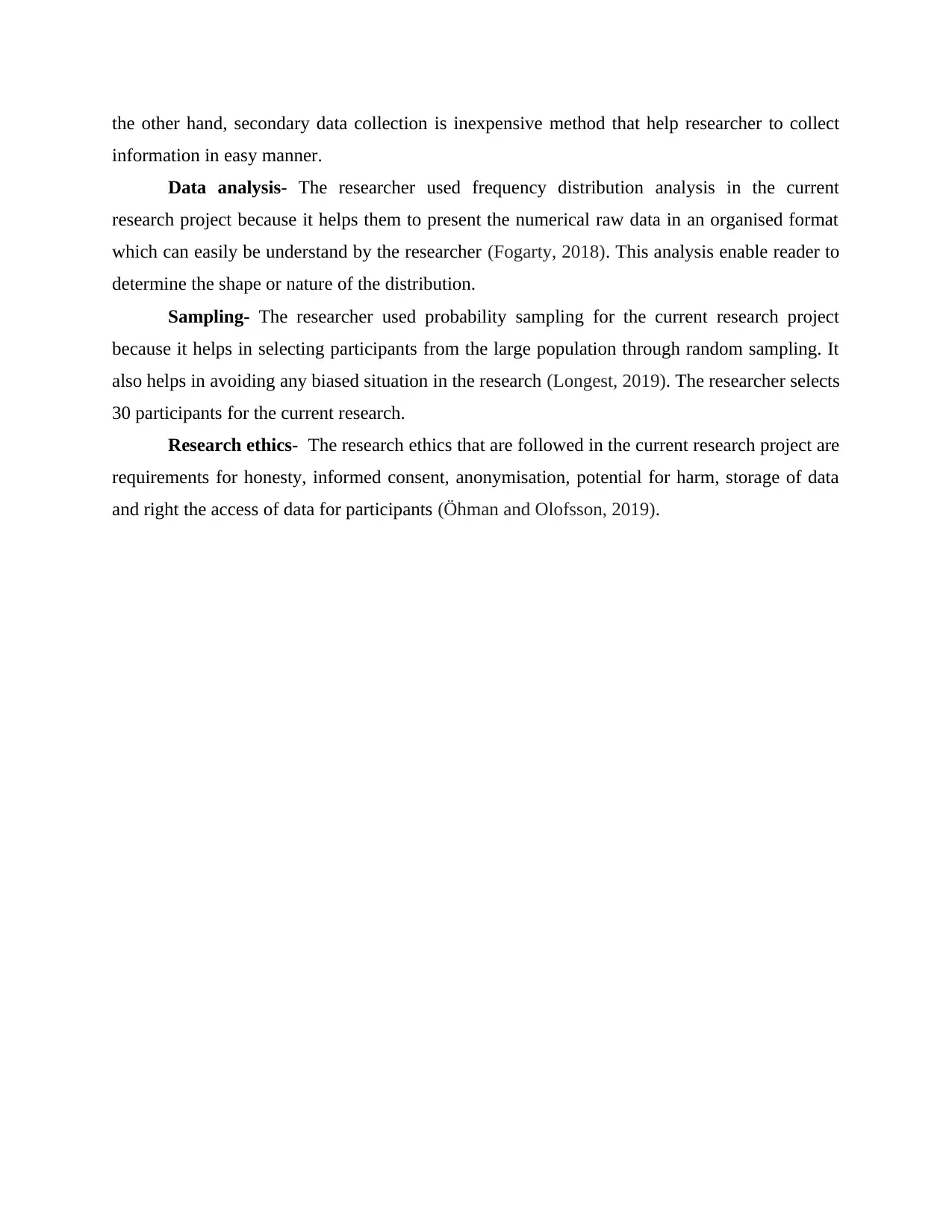
the other hand, secondary data collection is inexpensive method that help researcher to collect
information in easy manner.
Data analysis- The researcher used frequency distribution analysis in the current
research project because it helps them to present the numerical raw data in an organised format
which can easily be understand by the researcher (Fogarty, 2018). This analysis enable reader to
determine the shape or nature of the distribution.
Sampling- The researcher used probability sampling for the current research project
because it helps in selecting participants from the large population through random sampling. It
also helps in avoiding any biased situation in the research (Longest, 2019). The researcher selects
30 participants for the current research.
Research ethics- The research ethics that are followed in the current research project are
requirements for honesty, informed consent, anonymisation, potential for harm, storage of data
and right the access of data for participants (Öhman and Olofsson, 2019).
information in easy manner.
Data analysis- The researcher used frequency distribution analysis in the current
research project because it helps them to present the numerical raw data in an organised format
which can easily be understand by the researcher (Fogarty, 2018). This analysis enable reader to
determine the shape or nature of the distribution.
Sampling- The researcher used probability sampling for the current research project
because it helps in selecting participants from the large population through random sampling. It
also helps in avoiding any biased situation in the research (Longest, 2019). The researcher selects
30 participants for the current research.
Research ethics- The research ethics that are followed in the current research project are
requirements for honesty, informed consent, anonymisation, potential for harm, storage of data
and right the access of data for participants (Öhman and Olofsson, 2019).
Paraphrase This Document
Need a fresh take? Get an instant paraphrase of this document with our AI Paraphraser
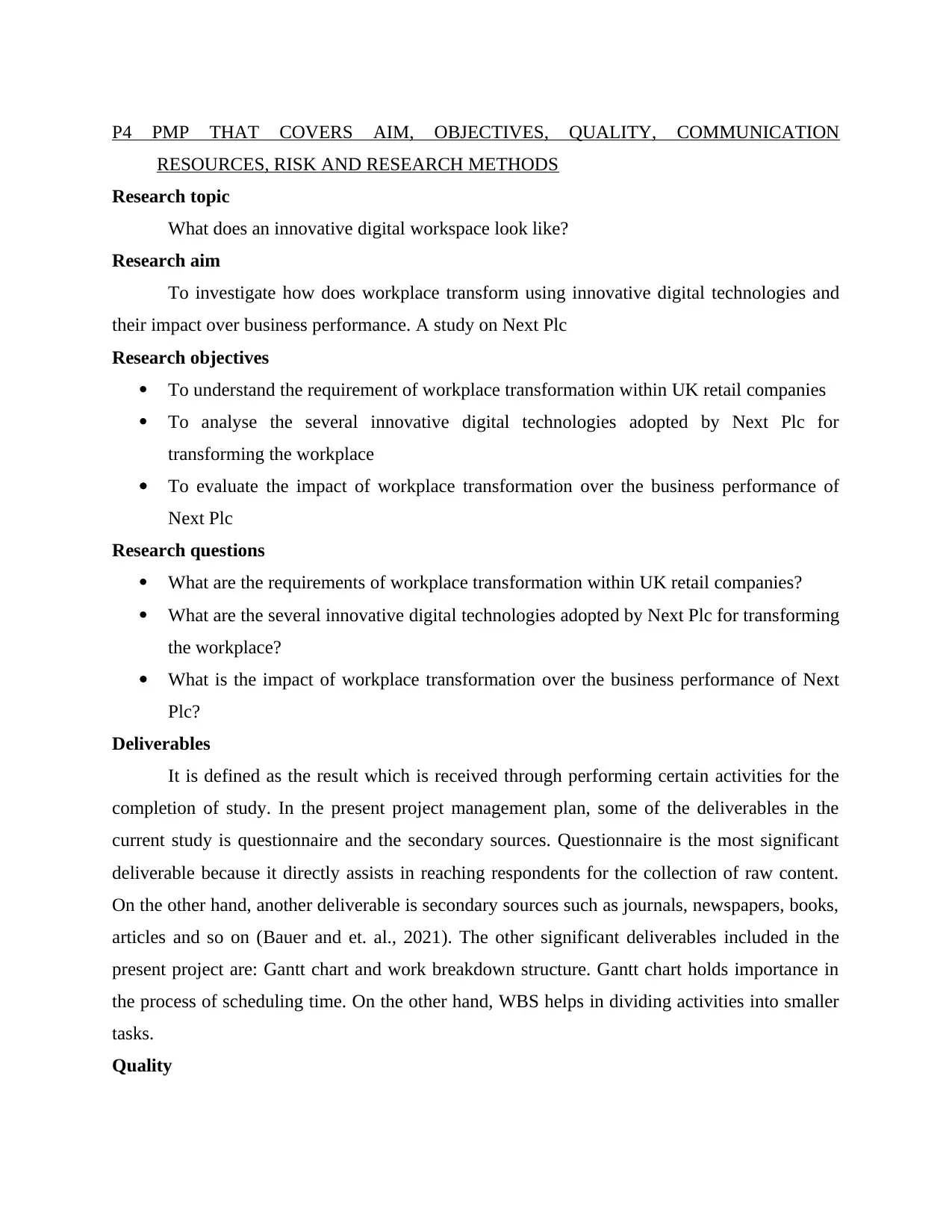
P4 PMP THAT COVERS AIM, OBJECTIVES, QUALITY, COMMUNICATION
RESOURCES, RISK AND RESEARCH METHODS
Research topic
What does an innovative digital workspace look like?
Research aim
To investigate how does workplace transform using innovative digital technologies and
their impact over business performance. A study on Next Plc
Research objectives
To understand the requirement of workplace transformation within UK retail companies
To analyse the several innovative digital technologies adopted by Next Plc for
transforming the workplace
To evaluate the impact of workplace transformation over the business performance of
Next Plc
Research questions
What are the requirements of workplace transformation within UK retail companies?
What are the several innovative digital technologies adopted by Next Plc for transforming
the workplace?
What is the impact of workplace transformation over the business performance of Next
Plc?
Deliverables
It is defined as the result which is received through performing certain activities for the
completion of study. In the present project management plan, some of the deliverables in the
current study is questionnaire and the secondary sources. Questionnaire is the most significant
deliverable because it directly assists in reaching respondents for the collection of raw content.
On the other hand, another deliverable is secondary sources such as journals, newspapers, books,
articles and so on (Bauer and et. al., 2021). The other significant deliverables included in the
present project are: Gantt chart and work breakdown structure. Gantt chart holds importance in
the process of scheduling time. On the other hand, WBS helps in dividing activities into smaller
tasks.
Quality
RESOURCES, RISK AND RESEARCH METHODS
Research topic
What does an innovative digital workspace look like?
Research aim
To investigate how does workplace transform using innovative digital technologies and
their impact over business performance. A study on Next Plc
Research objectives
To understand the requirement of workplace transformation within UK retail companies
To analyse the several innovative digital technologies adopted by Next Plc for
transforming the workplace
To evaluate the impact of workplace transformation over the business performance of
Next Plc
Research questions
What are the requirements of workplace transformation within UK retail companies?
What are the several innovative digital technologies adopted by Next Plc for transforming
the workplace?
What is the impact of workplace transformation over the business performance of Next
Plc?
Deliverables
It is defined as the result which is received through performing certain activities for the
completion of study. In the present project management plan, some of the deliverables in the
current study is questionnaire and the secondary sources. Questionnaire is the most significant
deliverable because it directly assists in reaching respondents for the collection of raw content.
On the other hand, another deliverable is secondary sources such as journals, newspapers, books,
articles and so on (Bauer and et. al., 2021). The other significant deliverables included in the
present project are: Gantt chart and work breakdown structure. Gantt chart holds importance in
the process of scheduling time. On the other hand, WBS helps in dividing activities into smaller
tasks.
Quality
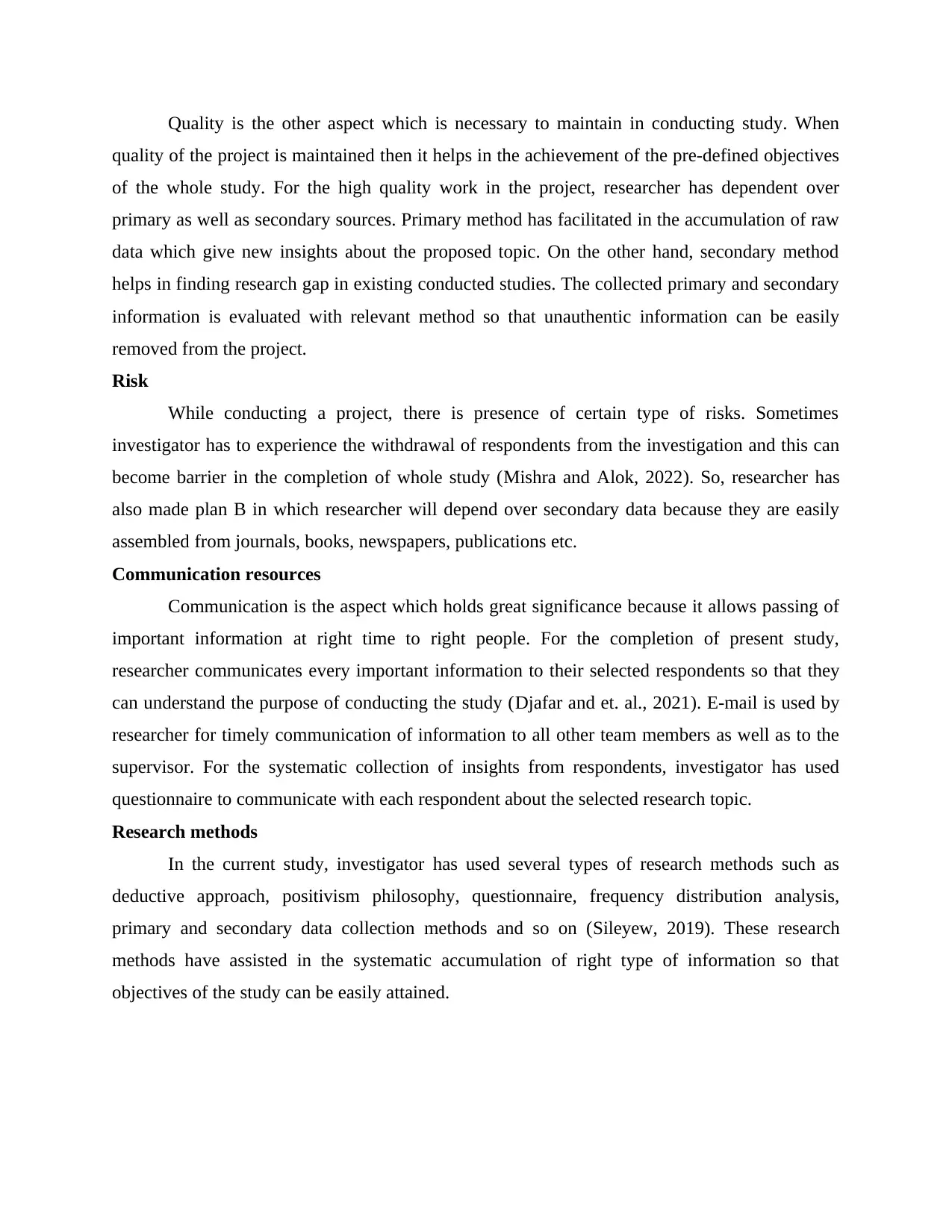
Quality is the other aspect which is necessary to maintain in conducting study. When
quality of the project is maintained then it helps in the achievement of the pre-defined objectives
of the whole study. For the high quality work in the project, researcher has dependent over
primary as well as secondary sources. Primary method has facilitated in the accumulation of raw
data which give new insights about the proposed topic. On the other hand, secondary method
helps in finding research gap in existing conducted studies. The collected primary and secondary
information is evaluated with relevant method so that unauthentic information can be easily
removed from the project.
Risk
While conducting a project, there is presence of certain type of risks. Sometimes
investigator has to experience the withdrawal of respondents from the investigation and this can
become barrier in the completion of whole study (Mishra and Alok, 2022). So, researcher has
also made plan B in which researcher will depend over secondary data because they are easily
assembled from journals, books, newspapers, publications etc.
Communication resources
Communication is the aspect which holds great significance because it allows passing of
important information at right time to right people. For the completion of present study,
researcher communicates every important information to their selected respondents so that they
can understand the purpose of conducting the study (Djafar and et. al., 2021). E-mail is used by
researcher for timely communication of information to all other team members as well as to the
supervisor. For the systematic collection of insights from respondents, investigator has used
questionnaire to communicate with each respondent about the selected research topic.
Research methods
In the current study, investigator has used several types of research methods such as
deductive approach, positivism philosophy, questionnaire, frequency distribution analysis,
primary and secondary data collection methods and so on (Sileyew, 2019). These research
methods have assisted in the systematic accumulation of right type of information so that
objectives of the study can be easily attained.
quality of the project is maintained then it helps in the achievement of the pre-defined objectives
of the whole study. For the high quality work in the project, researcher has dependent over
primary as well as secondary sources. Primary method has facilitated in the accumulation of raw
data which give new insights about the proposed topic. On the other hand, secondary method
helps in finding research gap in existing conducted studies. The collected primary and secondary
information is evaluated with relevant method so that unauthentic information can be easily
removed from the project.
Risk
While conducting a project, there is presence of certain type of risks. Sometimes
investigator has to experience the withdrawal of respondents from the investigation and this can
become barrier in the completion of whole study (Mishra and Alok, 2022). So, researcher has
also made plan B in which researcher will depend over secondary data because they are easily
assembled from journals, books, newspapers, publications etc.
Communication resources
Communication is the aspect which holds great significance because it allows passing of
important information at right time to right people. For the completion of present study,
researcher communicates every important information to their selected respondents so that they
can understand the purpose of conducting the study (Djafar and et. al., 2021). E-mail is used by
researcher for timely communication of information to all other team members as well as to the
supervisor. For the systematic collection of insights from respondents, investigator has used
questionnaire to communicate with each respondent about the selected research topic.
Research methods
In the current study, investigator has used several types of research methods such as
deductive approach, positivism philosophy, questionnaire, frequency distribution analysis,
primary and secondary data collection methods and so on (Sileyew, 2019). These research
methods have assisted in the systematic accumulation of right type of information so that
objectives of the study can be easily attained.
⊘ This is a preview!⊘
Do you want full access?
Subscribe today to unlock all pages.

Trusted by 1+ million students worldwide
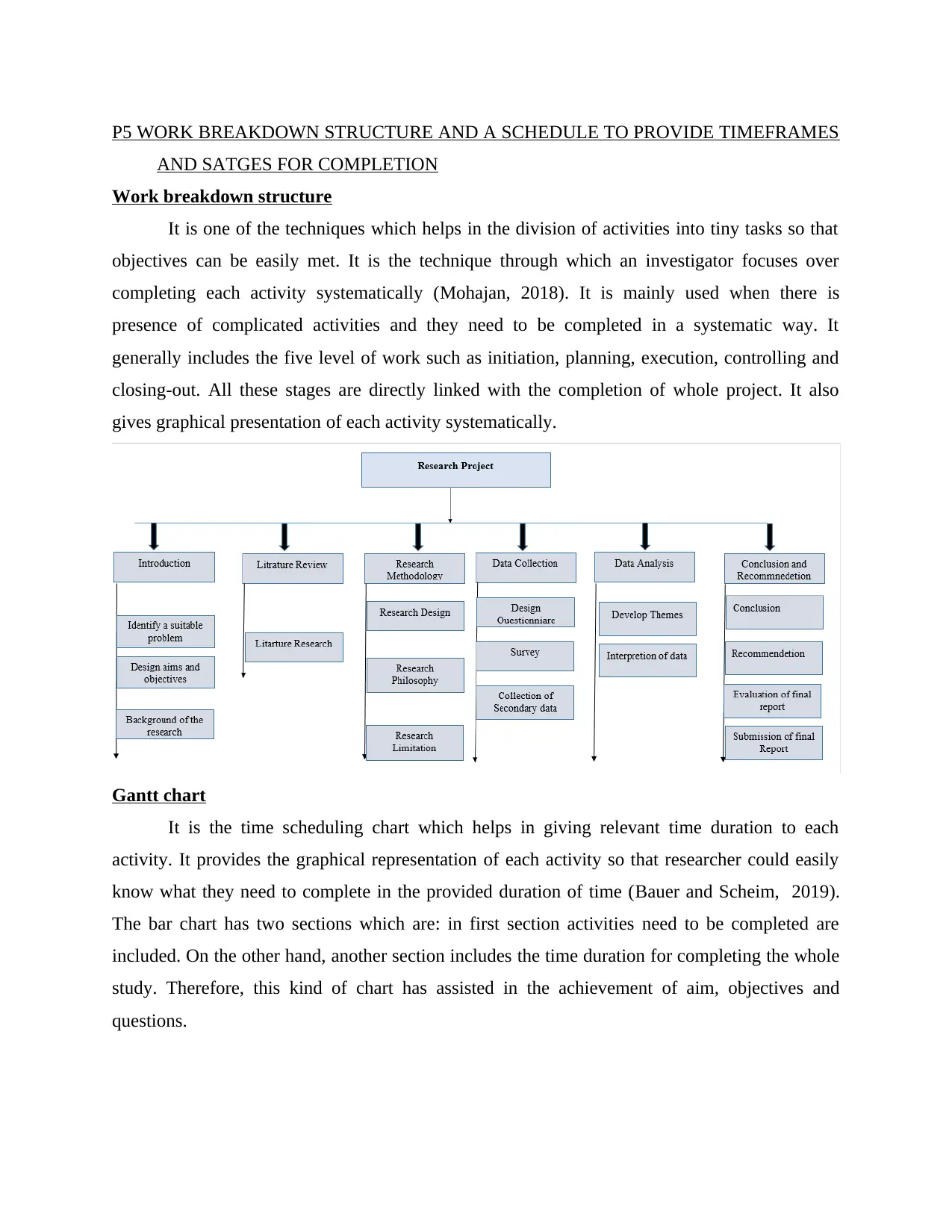
P5 WORK BREAKDOWN STRUCTURE AND A SCHEDULE TO PROVIDE TIMEFRAMES
AND SATGES FOR COMPLETION
Work breakdown structure
It is one of the techniques which helps in the division of activities into tiny tasks so that
objectives can be easily met. It is the technique through which an investigator focuses over
completing each activity systematically (Mohajan, 2018). It is mainly used when there is
presence of complicated activities and they need to be completed in a systematic way. It
generally includes the five level of work such as initiation, planning, execution, controlling and
closing-out. All these stages are directly linked with the completion of whole project. It also
gives graphical presentation of each activity systematically.
Gantt chart
It is the time scheduling chart which helps in giving relevant time duration to each
activity. It provides the graphical representation of each activity so that researcher could easily
know what they need to complete in the provided duration of time (Bauer and Scheim, 2019).
The bar chart has two sections which are: in first section activities need to be completed are
included. On the other hand, another section includes the time duration for completing the whole
study. Therefore, this kind of chart has assisted in the achievement of aim, objectives and
questions.
AND SATGES FOR COMPLETION
Work breakdown structure
It is one of the techniques which helps in the division of activities into tiny tasks so that
objectives can be easily met. It is the technique through which an investigator focuses over
completing each activity systematically (Mohajan, 2018). It is mainly used when there is
presence of complicated activities and they need to be completed in a systematic way. It
generally includes the five level of work such as initiation, planning, execution, controlling and
closing-out. All these stages are directly linked with the completion of whole project. It also
gives graphical presentation of each activity systematically.
Gantt chart
It is the time scheduling chart which helps in giving relevant time duration to each
activity. It provides the graphical representation of each activity so that researcher could easily
know what they need to complete in the provided duration of time (Bauer and Scheim, 2019).
The bar chart has two sections which are: in first section activities need to be completed are
included. On the other hand, another section includes the time duration for completing the whole
study. Therefore, this kind of chart has assisted in the achievement of aim, objectives and
questions.
Paraphrase This Document
Need a fresh take? Get an instant paraphrase of this document with our AI Paraphraser
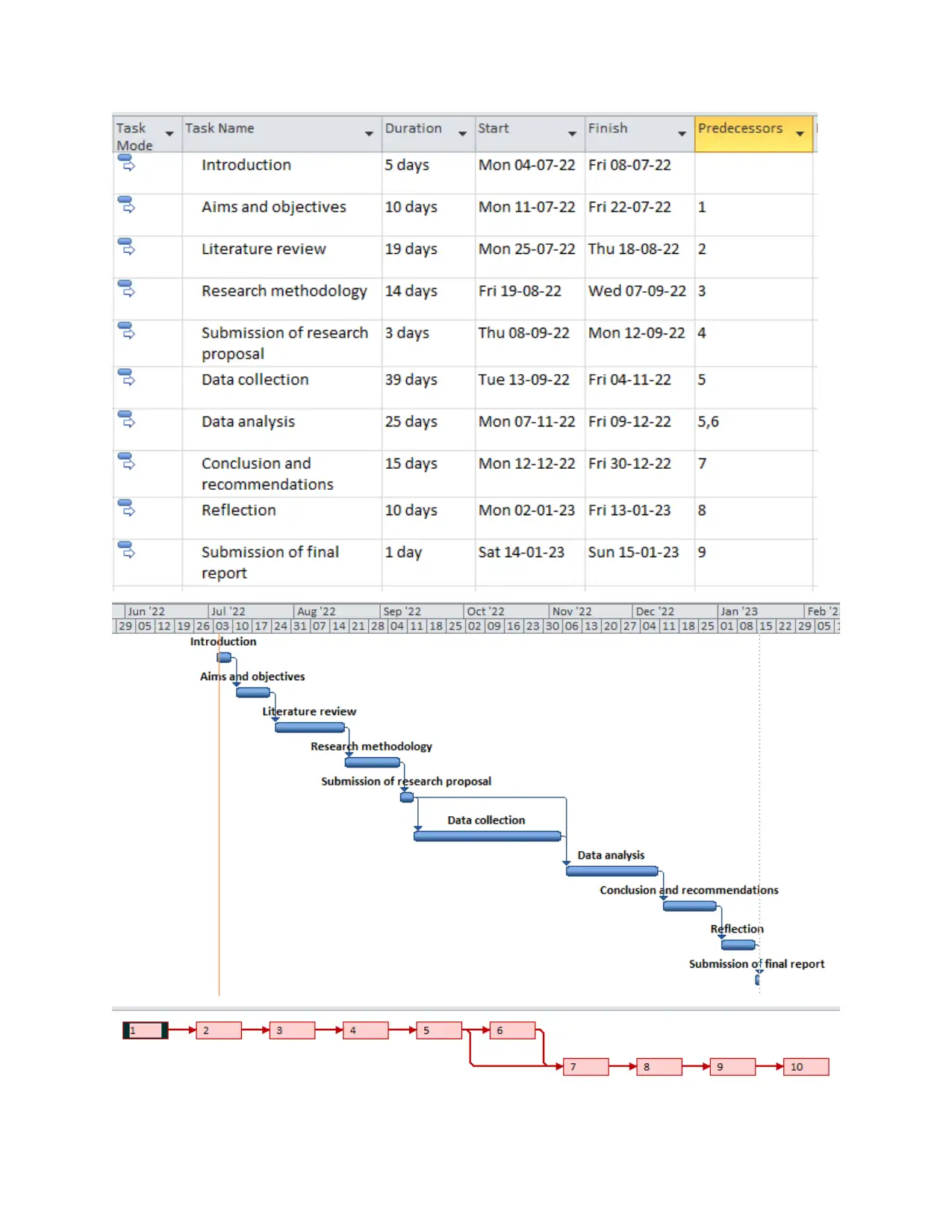

⊘ This is a preview!⊘
Do you want full access?
Subscribe today to unlock all pages.

Trusted by 1+ million students worldwide
1 out of 32
Related Documents
Your All-in-One AI-Powered Toolkit for Academic Success.
+13062052269
info@desklib.com
Available 24*7 on WhatsApp / Email
![[object Object]](/_next/static/media/star-bottom.7253800d.svg)
Unlock your academic potential
Copyright © 2020–2025 A2Z Services. All Rights Reserved. Developed and managed by ZUCOL.



